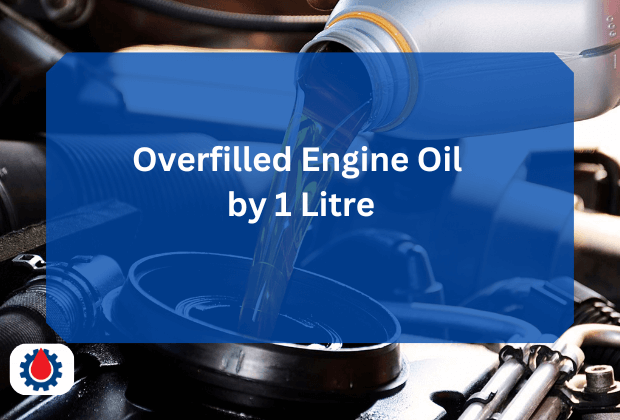Overfilling the engine oil, even by just one litre, can lead to significant issues that compromise performance, efficiency, and longevity. In this post, we’ll explore the consequences of overfilling engine oil by one litre, why it happens, and how to address it effectively.
Overfilled Engine Oil by 1 Litre
How Overfilling Happens
Overfilling engine oil is a common mistake, often resulting from human error or misunderstanding. Here are some typical scenarios:
- DIY Oil Changes: Enthusiasts or vehicle owners performing their own oil changes may misjudge the required oil volume, pouring in more than necessary.
- Misreading the Dipstick: Incorrectly reading the dipstick, especially if the vehicle is not on level ground or the engine is warm, can lead to overfilling.
- Topping Off Without Checking: Adding oil without first checking the current level can push the oil volume beyond the safe limit.
- Mechanic Errors: Even professionals can make mistakes, such as using the wrong oil capacity specification for a vehicle model.
Related Electric Engine Oil Pump(Top 5 Best 2025)
Consequences of Overfilling by One Litre
Overfilling engine oil by one litre can cause several problems, ranging from reduced efficiency to catastrophic engine damage. Here are the key risks:
1. Increased Crankcase Pressure
Excess oil can get churned by the crankshaft, leading to aeration (the formation of air bubbles in the oil). Aerated oil loses its lubricating properties, increasing friction and wear on engine components. Additionally, the excess oil increases pressure in the crankcase, which can strain seals and gaskets, potentially causing leaks.
2. Oil Foaming
When the crankshaft whips the excess oil, it creates foam. Foamed oil is less effective at lubricating, as it compresses under pressure, reducing the oil film strength. This can lead to metal-on-metal contact, accelerating wear on bearings, pistons, and other critical parts.
3. Damaged Seals and Gaskets
The increased pressure from overfilled oil can push against seals and gaskets, causing them to deform or fail. Leaking seals can result in oil loss, contamination, or even engine failure if the issue goes unaddressed.
Related Water in the Oil of the Engine(4 Causes + Solutions)
4. Catalytic Converter Damage
Excess oil may find its way into the combustion chamber, where it burns and produces excessive smoke. This can foul spark plugs and, in severe cases, damage the catalytic converter, an expensive component to replace.
5. Reduced Fuel Efficiency
An overfilled engine works harder due to increased resistance from the excess oil, leading to reduced fuel efficiency. This not only increases operating costs but also contributes to higher emissions.
6. Potential for Hydrostatic Lock
In extreme cases, excess oil can flood the cylinders, leading to hydrostatic lock, a condition where the engine cannot compress the oil, causing severe damage to pistons, rods, or even the engine block.
Related Engine Overheating After Oil Change(6 Causes + Solutions)
How to Detect Overfilled Engine Oil
If you suspect your engine oil is overfilled, check the dipstick. Ensure the vehicle is on level ground and the engine is cool. The oil level should be between the minimum and maximum marks. If it’s above the maximum, you’ve likely overfilled. Other signs include:
- White or blue exhaust smoke
- A burning oil smell
- Engine misfires or rough idling
- Reduced acceleration or sluggish performance
- Oil leaks around seals or gaskets
Related Car Engine Oil Capacity Chart(Car Model A to Z)
What to Do If You’ve Overfilled by One Litre
If you’ve added an extra litre of oil, don’t panic, prompt action can prevent damage. Follow these steps:
- Drain the Excess Oil: The simplest solution is to drain the excess oil. If you’re comfortable, loosen the drain plug under the vehicle to let out a small amount of oil, checking the dipstick frequently to ensure you don’t remove too much. Alternatively, visit a mechanic to have the oil level corrected.
- Use an Oil Extractor: If you don’t want to crawl under the vehicle, an oil extractor pump can remove the excess oil through the dipstick tube.
- Inspect for Damage: After correcting the oil level, monitor the vehicle for signs of damage, such as leaks or unusual noises. If you notice anything concerning, consult a professional mechanic.
- Change the Oil Filter: If the overfill caused significant foaming or contamination, consider replacing the oil filter to ensure clean oil circulation.
Related Does Service Engine Soon Mean Oil Change(Explained)
Preventing Overfilling in the Future
To avoid overfilling your engine oil:
- Always check the owner’s manual for the correct oil capacity.
- Use a clean dipstick and check levels on a flat surface with a cool engine.
- Add oil gradually, allowing it to settle before rechecking the level.
- If you’re unsure, consult a professional or use a trusted mechanic for oil changes.
Final words
Overfilling your engine oil by one litre may seem like a minor mistake, but it can lead to serious consequences if left unaddressed. From increased crankcase pressure to potential engine damage, the risks are significant. By knowing the causes, recognizing the symptoms, and taking prompt corrective action, you can protect your vehicle’s performance and longevity. Regular maintenance and careful attention to oil levels will keep your engine running smoothly for years to come.




